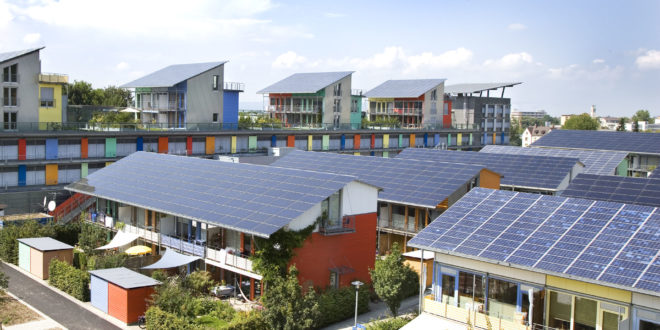As the eco-conscious movement expands, the demand for sustainable energy sources increases. In the U.S., most of our electricity derives from fossil fuels. During combustion, they create greenhouse gas emissions and create atmospheric degradation.
Environmental engineers and scientists evaluated energy-related challenges and developed sustainable solutions. They created more efficient, smaller, and modular energy grids using renewable resources to eliminate emissions. Solar microgrids produce several key advantages for local energy production, improving economic and environmental conditions.
What Are Solar Microgrids?
A solar microgrid is a smaller version of the conventional electric grid, relying on clean energy sources instead of fossil fuels. The large-scale version uses “dirty” resources to meet the nation’s energy needs, delivering optimal output around the clock. Researchers recently discovered methods of storing and mass-producing renewable electricity to meet real-time demands.
Individuals initially used solar production and storage systems as backup power sources. The decrease in solar energy costs promoted their everyday use, leading to the creation of the microgrid. Panel efficiency levels are also increasing as researchers develop devices with 50% sunlight-to-electricity conversion rates.
They are taking their technological energy production advancements and combining them with storage systems, creating reliable grids. The Vistra Moss Landing Energy Storage Facility generates and stores enough clean energy to power 300,000 Northern California homes. Vistra’s project repurposed an old power plant, placing massive lithium-ion batteries in unused smokestacks.
Researchers are studying the effects of renewable microgrids, like Moss Landing, and highlighting their advantages. There are six key benefits of solar microgrids for local energy production. Over time, the benefits may sway society to ditch fossil fuel electricity sources and adopt clean power.
1. Lowering Energy Costs
Solar power is the most cost-effective electricity source on the market. Microgrids reliant on renewable power provide low-cost and consistently priced electricity to local communities. Fossil fuels’ increasingly high prices limit many business owners’ abilities to meet utility demands.
Rising energy costs drive family farmers out of the industry annually, causing monopolies in the agricultural sector. Individuals can ensure the stability of their electricity prices when using solar microgrids. While residents shrink their utility bills, they can also shrink their carbon footprints.
2. Decreases Greenhouse Gas Emissions
Solar microgrids create various advantages for the environment. Fossil-fuel-derived electricity makes up a quarter of America’s greenhouse gas (GHG) emissions. When GHGs invade the atmosphere, they alter Earth’s natural temperature control process, driving climate change.
Solar energy produces zero combustion emissions. When we convert our conventional electricity reliance towards sustainable microgrids, we decrease atmospheric degradation. A solar microgrid can effectively enhance climate change prevention.
3. Improves Reliability
Conventional energy grids rely on depletable, off-site resources, creating frequent outages. American businesses lose nearly $150 billion each year from brownouts and blackouts. Solar power harnesses energy from onsite sunlight, virtually eliminating outages.
Business owners can install solar microgrids on manufacturing sites or around office buildings, increasing their energy reliability. They also improve their annual sales by eliminating power-related limitations.
4. Supports Green Employment
President Biden established the Build Back Better plan, increasing financial support for the sustainability sector. He allocated nearly $2 trillion to industry, hoping to create green employment opportunities. Expanding solar microgrids can generate new clean energy positions and increase job security.
The pandemic placed Americans in another recession, decreasing the stability of many families. Using solar microgrids to expand employment opportunities can keep society working. Over time, green jobs may pull the U.S. out of the recession, creating financial and emotional well-being.
5. Increases Resilience
A solar microgrid supports businesses during outages and can even prevent them. Increasing an energy system’s resilience is essential to a community’s safety. Cities can connect their essential and emergency services to solar power sources, helping them serve individuals during natural disasters.
Hurricane Sandy produced widespread, extended power outages. When the storm passed, tech companies like Panasonic and Sony developed hurricane-relief-specific solar systems. The technology grew into efficient microgrids that protect disaster-prone communities.
6. Enhances Community Health
Emission-free energy grids also support community health by decreasing surface and atmospheric pollution. Fossil fuel-derived electricity creates adverse emission-related health effects. Individuals in high air pollution regions have an increased risk of asthma and other respiratory illnesses.
As the global temperature rises, the evaporation rate rises too, increasing water scarcity. Resource displacement decreases society’s access to clean drinking water, expanding global dehydration. Rising summer temperatures and low water consumption rates create kidney distress and diseases.
A Greener Future
Adopting green technology can help us transition our energy portfolio away from fossil fuels. Reducing power-related emissions can help us meet our carbon-neutrality goals. We can also use solar microgrids to decentralize the electricity sector, lowering utility costs and improving consistency.
We can also use sustainable technology to develop a national-scale clean electricity grid. Eliminating the depletable resources related to energy production could improve environmental conservation and society’s well-being.



